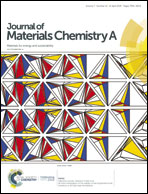High energy storage density and ultrafast discharge in lead lutetium niobate based ceramics†
Abstract
Linear dielectric and ferroelectric (FE) materials as dielectric capacitors have low energy density, which limits their application in high pulse power systems. As an alternative, antiferroelectric (AFE) materials have superior recoverable energy storage density and ultrafast discharge times due to their electric field induced phase transition. Herein, we report lead lutetium niobate (PLN)-based ceramic, which is an alternative AFE material due to its significantly enhanced energy storage density (6.43 J cm−3) compared to popular Pb(Zr,Ti)O3 (PZT)-based and lead-free perovskite AFE ceramics. Structural analysis revealed evidence of two types of AFE super-lattice. The energy storage properties remain stable up to 200 °C. Surprisingly, the PLN-based system exhibited the fastest known discharge (90% of the discharge energy density released in about 20 ns) and good fatigue resistance. The ultrafast discharge and the stabilities of the AFE/FE phases were explained using the Ginzburg–Landau–Devonshire (GLD) phenomenon. This study in AFE energy storage provides a potential alternative for application in pulse power devices.



 Please wait while we load your content...
Please wait while we load your content...